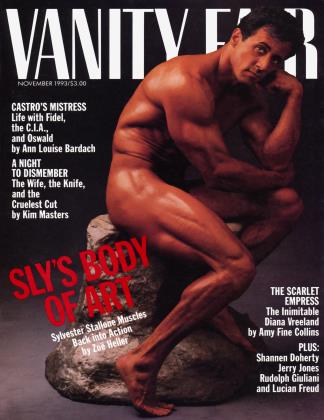Sign In to Your Account
Subscribers have complete access to the archive.
Sign In Not a Subscriber?Join NowEditor's Letter
Final Cut
As metaphors go, the battle of the sexes never had a more powerful image to contemplate: a young woman, who claims she was beaten down by her husband's abuse, philandering, and repeated rapes, reaches her breaking point, takes a kitchen knife, and, as Bone person who knew the couple puts it, goes "right to the source of what was hurting her." (Surgeons were able to reattach the source, but the point was effectively made.)
You are no doubt aware of the case. It happened in Virginia this summer and made national headlines. It will soon be in the news again: the man and the woman are both scheduled to stand trial, separately—he for marital sexual assault, she for "malicious wounding."
In discussions of the details of the case—the wife left the apartment clutching her husband's penis, drove off, and threw it into an open field adjacent to a nursery—some women cheer on her act of empowerment, while most men only wince. (Indeed, a current symbol of that empowerment is a parody of the old v-for-victory sign with a two-fingered, scissorslike motion.)
V.F. contributor Kim Masters's account of the story ("Sex, Lies, and an 8-Inch Carving Knife," page 168) marks the first time the wife, Lorena Bobbitt, has spoken to the print media about the events leading up to the night in question, the act itself, and her existence following those initial, horrifying headlines. Masters takes us inside the lives of this unhappy couple, along the way illuminating the larger issue of sexual politics in the 90s.
"There is so much unspoken implicit anger between men and women, evidenced in cases like the Clarence Thomas/Anita Hill hearings," says Masters. "I don't think men understand the level of women's visceral anger."
This month's remarkable cover of Sylvester Stallone, by the way, is the 100th cover story produced by V.F. features editor Jane Sarkin. In more than eight years at the magazine, she has also prepared countless features, Spotlights, and portfolios, including the annual, end-of-the-year Hall of Fame.
"It's the harder-to-get covers, the people who are reluctant to talk about themselves and be photographed, that turn out the best," says Sarkin. She's too modest by half—some of the others turn out pretty spectacularly, too.
Editor in chief
 View Full Issue
View Full Issue












Subscribers have complete access to the archive.
Sign In Not a Subscriber?Join Now